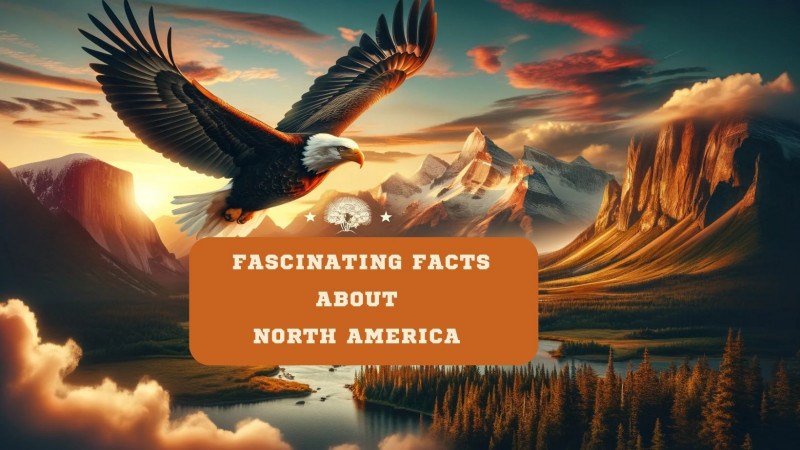
14 min
0
01.10.2024

As college students, we frequently find ourselves fully engrossed in the realm of academia, diligently studying textbooks and completing assignments. Nevertheless, pausing to investigate the captivating elements of our environment can be invigorating and eye-opening. Discover interesting facts about North America, from its diverse wildlife to its thriving art scene, in this article.
10 Fun Facts About North America
- It is the third-largest continent on Earth.
- It is home to 23 countries, each with its own unique traditions and heritage.
- It covers over 9.5 million square miles.
- The name America is derived from that of Italian navigator Amerigo Vespucci, who may have visited the mainland in 1497 and 1498.
- It features geographical extremes, from frozen Arctic tundras to lush Amazon rainforests.
- With 528 million inhabitants (2008 estimate), it is the 4th most populous continent; the United States ranks 3rd and Mexico 11th in population among the world's countries.
- Influential music genres like jazz, blues, and rock 'n' roll originated here shaping global music history.
- It is home to the world's longest international border, stretching over 5,525 miles (8,891 kilometers) between the United States and Canada.
- The continent boasts a diverse range of landscapes, from the vast deserts of the southwestern United States to the stunning Rocky Mountains and the Grand Canyon.
- It is the only continent to have every climatic zone represented, from arctic tundra in the north to tropical rainforests in the south.
Learning about the 10 facts about North America, including its diverse cultures, history, geographical extremes, and significant contributions to music, reveals the continent's rich and multifaceted character.
Nature's Marvels: Where Can You Find Komodo Dragons?
Surprisingly, you can encounter Komodo dragons here! These awe-inspiring reptiles can be found in nature preserves like the Dragon Marsh Preserve in Florida, offering a rare opportunity to witness these prehistoric-looking creatures outside their native Indonesia. This unique location serves as a quest for wildlife enthusiasts seeking to explore the exotic and the extraordinary, offering a rare glimpse into the world of these majestic creatures far from their Indonesian origins.
If you're curious about where you can find nature preserves with Komodo dragons in North America, Florida's Dragon Marsh Preserve is one such remarkable destination.
Discovering the Wildlife of the North American Continent
From the soaring bald eagle to the elusive wolverine, the continent is home to a remarkable variety of wildlife. Enchanting interactions with these magnificent creatures can be arranged through exploration of the continent's varied ecosystems.
Ancient Residents: Extinct Animals
Even though North American continent is famous for its living creatures, it also contains mysteries about long-gone creatures that once lived there.
The fossil record contains a wealth of information about extinct animals. Fascinating artifacts from the continent's prehistoric past include the Tyrannosaurus rex and the shaggy woolly mammoth. Fascinating prehistoric animals that formerly lived on this continent include the saber-toothed cat, American mastodon, and giant ground sloth.
Facing the Wild: Most Dangerous Animals
It is home to some of the world's most formidable animals. From the powerful grizzly bear to the stealthy cougar, understanding these creatures is essential for those exploring the continent's wilderness.
Cherishing Native Wildlife: What Animals Are Native to North America?
Many animals found here are native to the continent. The iconic North American bison, the swift pronghorn antelope, and the ancient American alligator are just a few examples of the unique and native species thriving here.
North America Animals List
- Bald Eagle: The majestic symbol of the United States, known for its impressive wingspan and striking appearance.
- Wolverine: An elusive and ferocious predator found in the remote wilderness areas.
- Grizzly Bear: A powerful and iconic bear species known for its size and strength.
- American Bison: Often called buffalo, these massive herbivores once roamed in vast herds across the continent.
- Red Fox: A cunning and adaptable predator that can be found in various North American habitats.
- Alligator: These reptilian giants inhabit swamps and wetlands in the southeastern United States.
- Moose: The largest member of the deer family, often seen in northern forests and wetlands.
- Humpback Whale: These majestic marine mammals migrate along North America's coastlines, offering spectacular whale-watching opportunities.
- Gray Wolf: An apex predator that roams parts of the continent, known for its social behavior and hunting prowess.
- Monarch Butterfly: An iconic insect species that undertakes an incredible migration journey.
Harnessing Nature's Energy: Nature Energy North America
Energy from the natural world is being harnessed in North American continent at a rapid pace. Sustainable power generation is aided by geothermal wonders such as Yellowstone National Park and hydroelectric dams along the Columbia River. Recently much research has been devoted to developing biofuels—energy from wastes, landfill gas, and crops—as well as to developing solar energy, wind power, and waterpower.
Population Insight: How Many People Live in North America in 2023?
In the year 2023, the continent is not just a geographical expanse but a vibrant tapestry of human life and culture. It is the 4th most populous continent; the United States ranks 3rd and Mexico 11th in population among the world's countries. The continent also includes Greenland, the largest island, as well as the small French overseas department of Saint-Pierre and Miquelon and the British dependency of Bermuda (both made up of small islands in the Atlantic Ocean).
With over 579 million people, the continent's population is ethnically and culturally mixed, fostering diversity and bringing together people from various backgrounds. This rich blend of perspectives and traditions adds depth and dynamism to North America's social fabric, making it a truly remarkable and ever-evolving part of the world.
Sports and Culture: A Widespread Belief Among Many People in North America
A widespread belief among many people in the region is that playing sports is not just a recreational activity but also a significant part of the culture. Events like the Super Bowl and the World Series capture the hearts of millions, showcasing the continent's passion for athletic competition.
This cultural emphasis on sports has given rise to numerous legendary athletes, iconic stadiums, and a thriving sports industry that resonates with people across the continent and beyond.
Celebrating Artistic Expression: North America Art and Art Schools
Famous artists have left an everlasting impression on the North American artistic landscape, creating a vibrant mosaic of inspiration. Famous museums like New York City's Museum of Modern Art and Los Angeles's Getty Center house world-class collections that inspire both art lovers and creators. These establishments have featured the masterpieces of renowned artists like James McNeill Whistler, whose nocturnal paintings, like "Whistler's Mother," have endured the test of time.
Warhol also had a significant impact on the pop art movement. His portraits of Marilyn Monroe and Campbell's Soup Cans are just two examples of his colorful and iconic works that have forever changed the face of art and popular culture.
Edward Hopper's mysterious and introspective stories in works like "Nighthawks" and "Automat," which depict urban life in the United States, continue to fascinate viewers. American realists hold Hopper in high esteem for his groundbreaking use of light and shadow.
Native American art, with its captivating totem poles and intricate beadwork, also reflects the rich cultural heritage of indigenous communities. Famous Native American artists who have made significant contributions to art, such as Fritz Scholder and Jaune Quick-to-See Smith, have become well-known around the world.
The rich artistic heritage is enhanced by the indigenous creative traditions that coexist with the works of renowned classical and modern artists. As a result, the region is a dynamic center for artistic discovery and advancement.
Nurturing Creativity: Best Art Schools in North America
For aspiring artists, North America offers some of the world's best art schools. Institutions like the Rhode Island School of Design (RISD), the School of the Art Institute of Chicago (SAIC), and the Pratt Institute provide top-notch education and opportunities for budding artists to hone their craft.
These renowned institutions have produced countless talented artists who have made significant contributions to the global art scene, making the region a hub of creative innovation and artistic excellence.
Intercontinental Influences on North American History
In the grand tapestry of North America's history, a myriad of global influences has played a vital role in shaping its narrative. The continent's past intertwines with Europe, notably through the United Kingdom, which once set its imperial sights across the Atlantic. This connection mirrors the interactions with South America, where countries like Brazil experienced the transformative discovery of gold and diamonds, altering their trajectories dramatically. Similarly, Oceania and its jewels like Fiji have had their own unique impacts.
France and Jamaica represent the diverse cultural influx that has enriched North America's soil, akin to the way Asia and India have contributed to the global mosaic. The legacy of British Colonization is a thread that runs deep, not just in North America but across continents, influencing countries like Kenya in Africa.
Speaking of Africa, nations such as Egypt (descendants of the ancient Egyptians, a people who originated in northeastern Africa) the Democratic Republic of the Congo, nation in central Africa, and Burundi, one of Africa’s smallest countries, share a history of complex interactions with North America, each adding a distinct strand to the continent's rich historical fabric. These interactions have often been driven by ideologies influenced by thinkers like John Stuart Mill and by the industrial and economic transformations seen in places like France, where the shift towards technological innovation in aerospace, defense, transportation, and other specialized industries significantly impacted global dynamics.
Exploring the Rich Tapestry of North America: A Quest for Discovery
Amazing animals, ancient artifacts, and a thriving culture are just a few of the many things that this continent has to offer. North American continent has something extraordinary to offer everyone, whether you're marveling at the beauty of Niagara Falls, immersing yourself in the world of art, or just enjoying a game of sports. It encourages us to embrace curiosity and explore our surroundings.
FAQ
What is the highest peak in North America?
What is the longest river in North America?
Which desert is located in North America?
What is the largest freshwater lake in North America?
Which country in North America has the most official languages?



